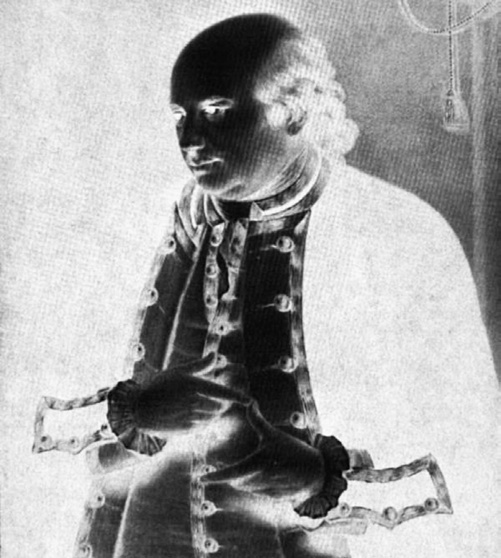The History of Florida (31 page)
Read The History of Florida Online
Authors: Michael Gannon
Tags: #History, #United States, #State & Local, #Americas

Rowland, Dunbar, and A. G. Sanders, eds.
Mississippi
Provincial
Archives:
French
Dominion,
1701–1743.
3 vols. Jackson: Press of the Mississippi Department of Archives and
History, 1927–29.
Spain. Archivo General de Indias. Testimony of Autos, no. 5, México 633, 1709.
Weddle, Robert S.
The
French
Thorn:
Rival
Explorers
in
the
Spanish
Sea,
1682–1762.
College Station: Texas A&M University Press, 1991.
9
British Rule in the Floridas
Robin F. A. Fabel and Daniel L. Schafer
In February 1763, representatives of Spain, France, and Great Britain signed
a peace treaty to end the Seven Years’ War (cal ed the French and Indian
War in North America). In the massive reshuffling of overseas territories
that fol owed Britain’s victories in the Caribbean, India, and North America,
Florida was acquired from Spain in exchange for Cuba, captured by British
troops in 1762. From France, Britain gained Canada, along with territory
adjoining Florida to the west and extending to the Mississippi River, with
the exception of the city of New Orleans and the Isle of Orleans, which went
proof
to Spain. French claims to land west of the Mississippi were also ceded to
Spain.
Britain divided the newly acquired Florida and Gulf Coast territories
into two provinces separated by the Apalachicola River. The land east of the
Apalachicola River and south of the St. Marys River became the province of
East Florida, with St. Augustine as its capital. West Florida extended west-
ward from the Apalachicola to the Mississippi River and incorporated the
Panhandle region of today’s state of Florida, much of Alabama and Missis-
sippi, and a portion of Louisiana. After a northward border adjustment in
1764, West Florida stretched from the Gulf of Mexico to the juncture of the
Mississippi and Yazoo Rivers, and from there eastward to the Apalachicola.
This border extension incorporated the rich farmland on the east bank of
the Mississippi in the Natchez region.
On July 20, 1763, Captain John Hedges and four companies of the British
First Regiment, later known as the “Royal Scots,” arrived at St. Augustine.
After observing ceremonies in honor of the Spanish king and queen, Cap-
tain Hedges raised the flag of Great Britain—the Union Jack—over the Cas-
tillo de San Marcos, the imposing coquina stone fortification alongside the
· 144 ·
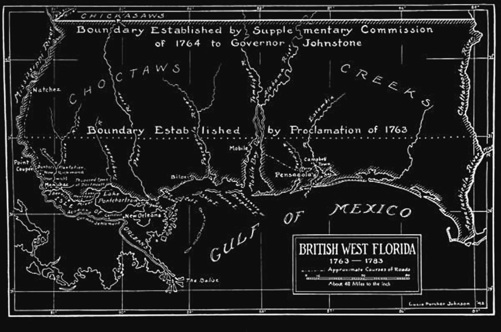
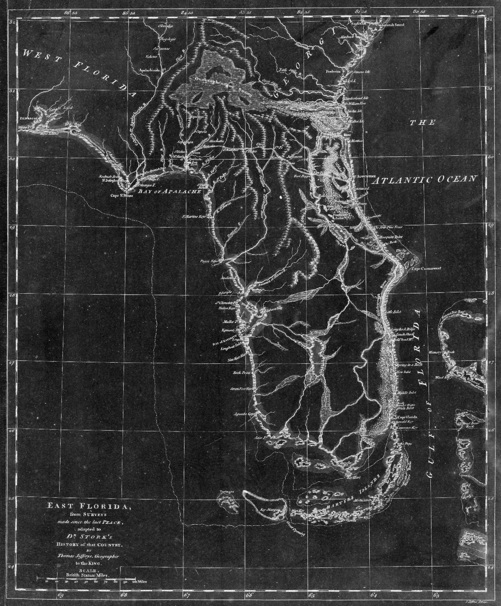
Map of British West Florida, showing the 1763 and 1764 boundaries and the few towns
that existed at the time. Courtesy of the Mississippi Department of Archives and His-
tory, http://mdah.state.ms.us/.
proof
British East Florida,
1763, by Thomas
Jefferys. London: W.
Nicoll, 1769. Courtesy
of University of South
Florida Libraries,
Special and Digital
Collections, http://
digital.lib.usf.edu/
civ/?doi=U15-0025.
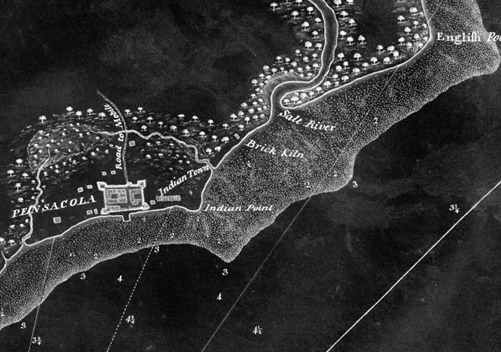
146 · Robin F. A. Fabel and Daniel L. Schafer
Pensacola ca. 1763, drawn by an anonymous British cartographer depicting the “Indian
Town” adjacent to Spanish Fort San Miguel. Approximately 120 Yamasee and Apalachee
inhabited the town in 1763; they were transported to Vera Cruz, Mexico, when the Brit-
ish took control of West Florida. Courtesy of Professor John Worth, University of West
proof
Florida, http://www.uwf.edu/jworth/colonialfrontiers.htm.
Matanzas River at the northeast corner of the city. For the next two decades,
the Castillo would be known as Castle, or Fort, St. Mark.
Ten days after the British flag was raised, Major Francis Ogilvie of the
Ninth Regiment assumed command. Soldiers who arrived with Hedges
were given the choice of joining the Ninth Regiment or mustering out of the
army to become civilian residents of St. Augustine. Major Ogilvie and Span-
ish Governor Melchoir Feliú maintained peaceful relations until transports
carried away the last of the 3,500 Spanish residents on January 21, 1764. Only
three Spanish families remained under British rule.
At Pensacola, the designated seat of government for British West Florida,
British troops under Lieutenant Colonel Augustine Prevost arrived on Au-
gust 5, 1763. One month later, 800 Spanish subjects departed Pensacola for
Havana and Veracruz, leaving behind approximately 350 French residents
of Mobile and another ninety French families settled on farms nearby. Colo-
nel Prevost complained about the miserable conditions of the fort and the
absence of cultivated fields in the surrounding countryside.
Prevost and Ogilvie recognized the necessity of establishing peaceful
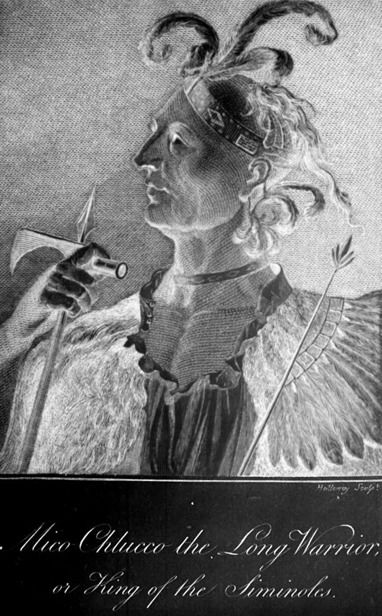
British Rule in the Floridas · 147
relations with the Native Americans of their respective provinces. The com-
bined populations of the Chickasaw, Choctaw, and Creek nations of West
Florida totaled nearly 28,000, whereas the total European population of
West Florida as late as 1765 was only 2,315. In East Florida, Major Ogilvie
traveled to the Creek vil ages in the Alachua region west of St. Augustine
with gifts for Chief Cowkeeper and his brother, the Long Warrior. Several
years before, Chief Cowkeeper and 130 families had left Oconee in Georgia
and settled in the rich farming and grazing lands near today’s city of Gaines-
ville. Land there had been vacant since the former inhabitants, the Timucua
Indians, had been decimated to the point of extinction by epidemic dis-
eases. The Creek under Cowkeeper were in the process of establishing a
separate identity as the Seminole.
proof
Mico-chlucco. King of
the Muscogulges or
Cricks called the Long
Warrior. Portrait by
the famed naturalist
William Bartram, who
visited the Seminole vil-
lages in Alachua during
his second explora-
tion of East Florida in
1774. Long Warrior
was not “King of the
Muscogulges”; rather,
he was the war leader
for the Creek under
Chief Cowkeeper who
migrated from Oconee
in Georgia to Alachua
in north Florida. Im-
age courtesy of the
American Philosophical
Society, Philadelphia.
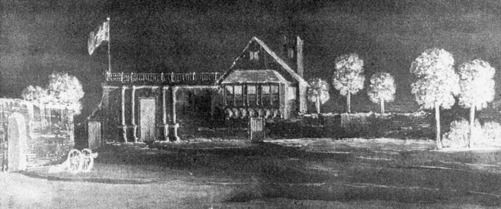
148 · Robin F. A. Fabel and Daniel L. Schafer
The former Spanish Governor’s House on the plaza in St. Augustine served the British
governors of East Florida from 1763 to 1784. This watercolor sketch, of British origin, is
dated November 1764.
The first governor of East Florida, Colonel James Grant, arrived at St.
Augustine in August 1764. A native of Scotland, Grant was shocked by the
miniscule size of the provincial capital. Passengers who debarked at a wharf
on the Matanzas River and walked westward on the city’s sand-filled streets
crossed only four intersecting streets before reaching the barricade and re-
doubts at the edge of town. The distance from the town’s barrier wall on the
proof
north to the southern barricade was less than one mile. The 300 dwellings
within the walled town were less than fifty years old. Fires, wood rot, ter-
mites, and the English siege of 1702 had destroyed most traces of the six-
teenth- and seventeenth-century city. The dwellings standing in 1763 were
mostly one-story, made of quarried coquina stone, tabby or wood.
In typical Spanish colonial fashion, St. Augustine centered on a plaza
surrounded by important public buildings. Streets radiated north and south
bounded by stores and residences. The dominant structures were the Gov-
ernor’s House at the west end of the plaza and Fort St. Mark. The governor
distributed town lots and houses among British officials, merchants, and
settlers.
When Captain George Johnstone of the Royal Navy, the first governor of
British West Florida, arrived at Pensacola in October 1764, he found an im-
pressive natural harbor but only 112 dilapidated and abandoned dwellings.
Elias Durnford, the provincial surveyor, drew up a plan for a new Pensacola
that allocated town lots to incoming settlers without charge, but it was 1768
before two hundred houses were standing. Members of the Royal Coun-
cil for each province were appointed by King George III and were cal ed
into session soon after the arrival of their respective governors. Despite
